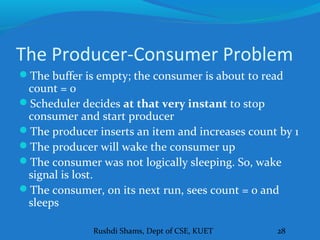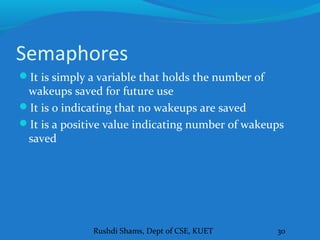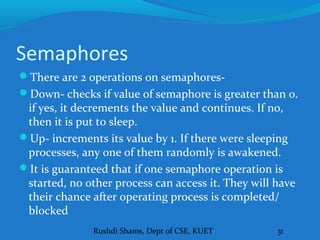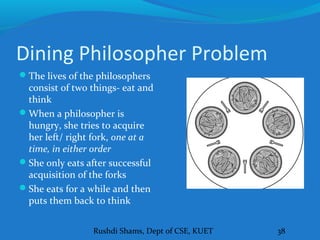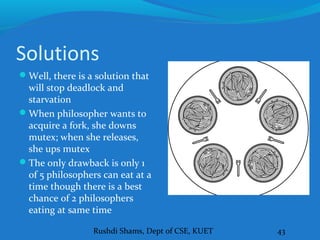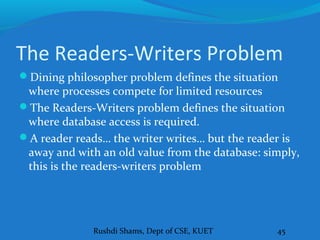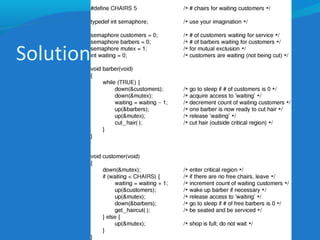Lecture 7, 8, 9 and 10 Inter Process Communication (IPC) in Operating Systems
- 1. Rushdi Shams, Dept of CSE, KUET 1 Operating SystemsOperating Systems Inter-processInter-process CommunicationCommunication Version 1.0
- 2. Rushdi Shams, Dept of CSE, KUET 2 IPC One process, sometimes, require the output of other process Therefore, there is a need of well structured communication among processes. Not preferring interrupts to draw attention.
- 3. Rushdi Shams, Dept of CSE, KUET 3 IPC Three issues in IPC- 1. How one process can pass information to another 2. Making sure that two or more processes do not get into each other’s way when engaging in critical activities (both wants last 1 MB space of virtual memory) 3. Proper sequencing when dependency is present (if A produces data that B prints, then B cannot print unless A is producing some data)
- 4. Rushdi Shams, Dept of CSE, KUET 4 Inter-thread Communication In case of ITC, the same issues are concerns. The first one is not a headache as threads share some common resources and address space; so, they can easily communicate But the other twos are issues in ITC as well.
- 5. Rushdi Shams, Dept of CSE, KUET 5 Race Condition A process wants to print a file. It enters the file name in a special printer directory The Printer Daemon periodically checks to see if there is any file to print If any file is there the Printer Daemon prints them and removes their names from the directory
- 6. Rushdi Shams, Dept of CSE, KUET 6 Race Condition Imagine our directory has a very large number of slots (numbered 0,1,2,…) and each one can hold a file name There are two shared variables- out that points to the next file to be printed and in that points to the next free slot in the directory
- 7. Rushdi Shams, Dept of CSE, KUET 7 Race Condition
- 8. Rushdi Shams, Dept of CSE, KUET 8 Race Condition A reads in and stores the values 7 to its local variable Then a context switch from A to B occurs B also reads in and stores the value 7 to its local variable B continues to run and it stores the name of its file in slot 7 and updates in to 8. Then it goes off and does other things
- 9. Rushdi Shams, Dept of CSE, KUET 9 Race Condition A runs again starting from the place it left off It looks its local variable and finds 7 there and writes the file name in slot 7 Then A sets in to 8 As everything went fine, the printer daemon will not raise any error
- 10. Rushdi Shams, Dept of CSE, KUET 10 Race Condition Process B never gets the chance Situations like this where two or more processes are reading or writing some shared data and the final result depends on who ran precisely are called race conditions
- 11. Rushdi Shams, Dept of CSE, KUET 11 Critical Regions How can we avoid race conditions? One way to avoid that is prohibiting more than one process from reading and writing the shared data at the same time This is called Mutual Exclusion
- 12. Rushdi Shams, Dept of CSE, KUET 12 Critical Regions On the other hand, let’s think in abstract way. A process is busy doing internal computations and other things that do not lead race conditions And sometimes it is busy to access shared memory and files or in doing other critical things that lead race conditions The part of the program where shared memory or resources are accesses is called Critical Regions
- 13. Rushdi Shams, Dept of CSE, KUET 13 Critical Regions We need four conditions to hold for a good solution with mutual exclusion- 1. No two processes simultaneously in critical region 2. No assumptions made about speeds or numbers of CPUs 3. No process running outside its critical region may block another process 4. No process must wait forever to enter its critical region
- 14. Rushdi Shams, Dept of CSE, KUET 14 Mutual Exclusion with Critical Regions
- 15. Rushdi Shams, Dept of CSE, KUET 15 How can we achieve mutual exclusion? Now, let’s examine various proposals to achieve mutual exclusion While one process is busy to update shared memory in its critical region, no other process will enter its critical region and cause trouble
- 16. Rushdi Shams, Dept of CSE, KUET 16 Disabling Interrupts When a process enters into its critical region, it disables all interrupts While leaving its critical region, it re-enables all interrupts Unattractive and unwise to give user processes the power of turning off interrupts. What if one of them did it and never turned them on again!! That is the end of the system!!! It is often useful technique within the OS itself but not suitable as a general mutual exclusion mechanism
- 17. Rushdi Shams, Dept of CSE, KUET 17 Lock Variables It’s a software solution When a process wants to enter into the critical region, it checks the lock variable If it is 0, the process sets it to 1 and enters into its critical region If it is 1, the process waits
- 18. Rushdi Shams, Dept of CSE, KUET 18 Lock Variables One process reads the lock and sees 0 Before it sets 1, another process is scheduled, runs and sets the lock 1 When the first process runs, it will also set the lock 1 Two processes will be in their critical regions in the same time.
- 19. Rushdi Shams, Dept of CSE, KUET 19 Strict Alternation turn is a variable initially 0 keeps track of whose turn it is to enter critical regions Process 0 inspects turn and finds 0 and enters into its critical region Process 1 finds turn to be 0 and continuously tests the value of turn Continuously testing a variable until some value appears is called Busy Waiting
- 20. Rushdi Shams, Dept of CSE, KUET 20 Strict Alternation It should usually be avoided as it wastes CPU time Can be useful when short busy waiting is probable Requires strict alternating process to provide better result Inefficient when one process is much slower than the other
- 21. Rushdi Shams, Dept of CSE, KUET 21 Peterson’s Solution
- 22. Rushdi Shams, Dept of CSE, KUET 22 So far, the techniques we learnt (except disabling interrupts)- 1. Lock variables 2. Strict Alternation 3. Peterson’s Solution To achieve mutual exclusion, all have a common problem- Busy Waiting In case of prioritized scheduling, low prioritized processes will never be fed if Busy Waiting takes place
- 23. Rushdi Shams, Dept of CSE, KUET 23 Different Mechanisms with Sleep and Wake Now, we will see more mechanisms to achieve mutual exclusion These techniques will use Sleep and Wake- two system calls Sleep causes a process to be suspended until another process wakes it up Wake causes a process to wake up
- 24. Rushdi Shams, Dept of CSE, KUET 24 The Producer-Consumer Problem When the producer sees a full buffer and goes to sleep. When the consumer takes out an item, it awakes the producer When the consumer sees an empty buffer and goes to sleep. When the producer puts an item, it awakes the consumer
- 25. Rushdi Shams, Dept of CSE, KUET 25 The Producer-Consumer Problem We will use count as a variable to stop race conditions If the maximum no of information the buffer stores in N, then producer first checks if count = N. If yes, then it sleeps; otherwise it will add an item and increment count by 1 The consumer tests count. If count = 0, then it sleeps; otherwise it removes an information and decrements count by 1
- 26. Rushdi Shams, Dept of CSE, KUET 26 The Producer-Consumer Problem
- 27. Rushdi Shams, Dept of CSE, KUET 27 The Producer-Consumer Problem Two processes share a common, fixed-sized buffer The producer puts information into the buffer The consumer takes it out Problem arises when- 1. Producer wants to put information into a buffer that is full 2. Consumer wants to get information from a buffer that is empty
- 28. Rushdi Shams, Dept of CSE, KUET 28 The Producer-Consumer Problem The buffer is empty; the consumer is about to read count = 0 Scheduler decides at that very instant to stop consumer and start producer The producer inserts an item and increases count by 1 The producer will wake the consumer up The consumer was not logically sleeping. So, wake signal is lost. The consumer, on its next run, sees count = 0 and sleeps
- 29. Rushdi Shams, Dept of CSE, KUET 29 The Producer-Consumer Problem Soon, the producer fills up the buffer and also goes to sleep Both will sleep forever The main problem here is the lost wake up signal. If it were not lost, everything would have worked To solve this problem, we can use wake up waiting bit When a wake up is sent to a process (producer or consumer) that is not sleeping, this bit will be set. When the sender goes to sleep, it checks this bit If it is on, then the process will not sleep itself (because someone MAYBE sleeping)
- 30. Rushdi Shams, Dept of CSE, KUET 30 Semaphores It is simply a variable that holds the number of wakeups saved for future use It is 0 indicating that no wakeups are saved It is a positive value indicating number of wakeups saved
- 31. Rushdi Shams, Dept of CSE, KUET 31 Semaphores There are 2 operations on semaphores- Down- checks if value of semaphore is greater than 0. if yes, it decrements the value and continues. If no, then it is put to sleep. Up- increments its value by 1. If there were sleeping processes, any one of them randomly is awakened. It is guaranteed that if one semaphore operation is started, no other process can access it. They will have their chance after operating process is completed/ blocked
- 32. Rushdi Shams, Dept of CSE, KUET 32 Producer-Consumer Problem with Semaphores
- 33. Rushdi Shams, Dept of CSE, KUET 33
- 34. Rushdi Shams, Dept of CSE, KUET 34 Barriers Some applications are divided into phases And have the rule that no process may proceed to the next phase until all processes are ready to proceed to the next phase. This behavior maybe achieved by placing a Barrier at the end of each phase. When a process reaches the barrier, it is blocked until all processes reach the barrier.
- 35. Rushdi Shams, Dept of CSE, KUET 35 Barriers
- 36. Rushdi Shams, Dept of CSE, KUET 36 Classical IPC Problems
- 37. Rushdi Shams, Dept of CSE, KUET 37 Dining Philosopher Problem Five Philosophers seated around the circular table Each has a plate of Spaghetti Each needs two forks to eat it Between each pair of plates there is one fork
- 38. Rushdi Shams, Dept of CSE, KUET 38 Dining Philosopher Problem The lives of the philosophers consist of two things- eat and think When a philosopher is hungry, she tries to acquire her left/ right fork, one at a time, in either order She only eats after successful acquisition of the forks She eats for a while and then puts them back to think
- 39. Rushdi Shams, Dept of CSE, KUET 39 Dining Philosopher Problem Is it possible to have a solution so that no philosophers will be annoyed? (when her turn is eating, she eats; when her turn is thinking, she thinks)
- 40. Rushdi Shams, Dept of CSE, KUET 40 Solutions Philosopher will wait until its desired fork is available She will grab it when it’s available What if all the five philosophers take their left forks simultaneously? None will be able to take their right forks; there will be deadlock
- 41. Rushdi Shams, Dept of CSE, KUET 41 Solutions After taking the left fork, philosopher will check if its right fork is available If it’s not, philosopher puts back her left fork, wait for some times and proceeds again in similar way What if all philosophers start simultaneously? They will never find their right fork available causing starvation
- 42. Rushdi Shams, Dept of CSE, KUET 42 Solutions Using random start timer can solve this problem, but not ultimately Ethernet LAN works in this way, and this happens to be finer solution, but again, not the best; there is always a chance to have a failure
- 43. Rushdi Shams, Dept of CSE, KUET 43 Solutions Well, there is a solution that will stop deadlock and starvation When philosopher wants to acquire a fork, she downs mutex; when she releases, she ups mutex The only drawback is only 1 of 5 philosophers can eat at a time though there is a best chance of 2 philosophers eating at same time
- 44. Rushdi Shams, Dept of CSE, KUET 44 Solutions Our last solution will be deadlock free and achieve maximum parallelism. A philosopher will have 3 states- eating, thinking, or hungry (trying to acquire forks) A philosopher will move to eating state only if none of the neighbors is eating Only need is that each philosopher will have individual semaphores
- 45. Rushdi Shams, Dept of CSE, KUET 45 The Readers-Writers Problem Dining philosopher problem defines the situation where processes compete for limited resources The Readers-Writers problem defines the situation where database access is required. A reader reads… the writer writes… but the reader is away and with an old value from the database: simply, this is the readers-writers problem
- 46. Rushdi Shams, Dept of CSE, KUET 46 Solutions When a reader comes along, it UPs a semaphore- means, hey, we are reading, do not disturb If a writer comes, then it has to wait. If more readers come, they are allowed If reader comes along and along the writer just sits duck.
- 47. Rushdi Shams, Dept of CSE, KUET 47 Solution When an active reader is reading, then a writer comes. It sees that a reader is reading, the writer then waits If more reader comes, they are queued When the active reader finishes, the writer takes place its schedule After finishing of writer, the queued readers are given chances. Concurrency problem and lower performance is key issue here
- 48. Rushdi Shams, Dept of CSE, KUET 48 The Sleeping Barber Problem In a barber shop, there is one barber, some chairs and some customers A barber sleeps if there is no customer (not even on chairs, waiting for a haircut ) A customer wakes up the barber if it’s his turn to get his haircut A customer waits if there is any chair left A customer leaves, if all the chairs are occupied
- 49. Rushdi Shams, Dept of CSE, KUET 49 Solution
- 50. Rushdi Shams, Dept of CSE, KUET 50 Reference Modern Operating Systems (2nd Edition) by Andrew S. Tanenbaum




























